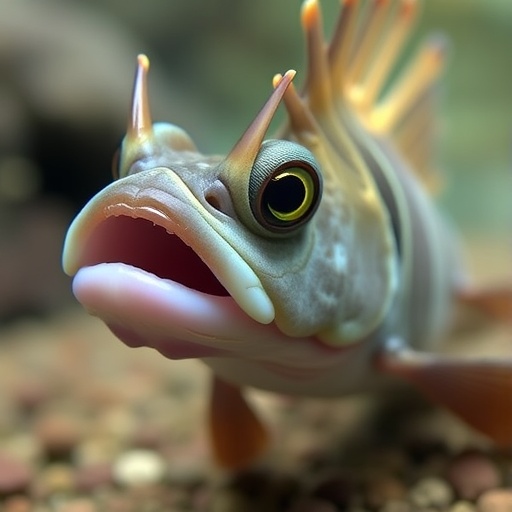In a groundbreaking discovery that challenges long-held assumptions about the location and evolution of teeth in vertebrates, researchers have identified a unique set of teeth growing not within the mouth, but on the forehead of the adult male spotted ratfish. This species, a member of the enigmatic group known as chimaeras, exhibits rows of hooked, retractable teeth lining a specialized cartilaginous structure called the tenaculum. The finding compels evolutionary biologists to reconsider the traditional notion that teeth are exclusively oral elements, revealing a previously unknown diversity in tooth development and placement.
The spotted ratfish, native to the northeastern Pacific Ocean and particularly abundant around Puget Sound, offers a rare window into evolutionary history. Unlike sharks, rays, and skates, which bear dermal denticles or tooth-like scales covering much of their bodies, the spotted ratfish is notably “naked,” lacking these structures with the exception of those on its pelvic claspers and this newly documented tenaculum. The tenaculum itself is a small, white, peanut-shaped appendage between the eyes during rest, which becomes erect and barbed with rows of formidable teeth in mature males.
The evolutionary implications of these teeth extend far beyond mere anatomical curiosity. Teeth are the products of a complex developmental process regulated by a conserved genetic toolkit shared among vertebrates. What the researchers uncovered, through detailed micro-CT scans, tissue analyses, and gene expression studies, is the presence of dental lamina—the critical band of tissue responsible for tooth development—beyond the confines of the oral cavity. Traditionally, it was believed this structure only existed inside the jaws, making the presence of dental lamina on the tenaculum a revolutionary observation.
From a developmental perspective, these findings suggest that a cluster of tooth-forming cells migrated from the oral region to the forehead during embryogenesis. In male spotted ratfish, the tenaculum initiates as a small protrusion which grows and mineralizes, eventually erupting through the skin and sprouting true teeth. In females, this process halts early and the tenaculum remains underdeveloped, highlighting a clear case of sexual dimorphism linked to reproductive behaviors.
Functionally, the toothed tenaculum serves an essential role in mating. Because sharks, ray-like fish, and chimaeras lack limbs, males have evolved diverse grasping structures to maintain contact with females during the physically demanding reproductive act underwater. The tenaculum’s hooked teeth latch firmly onto the female’s pectoral fin, complementing the function of the pelvic claspers, which inseminate the female. This adaptation ensures successful copulation despite the challenges posed by aquatic environments.
The bridge between fossil evidence and modern species strengthens the evolutionary narrative. Fossilized remains of ancient relatives to the spotted ratfish exhibit similar toothed structures on their tenacula, indicating that this trait has deep historical roots extending millions of years back. Paleontological data, coupled with modern genetic and anatomical studies, elucidate the repurposing of an ancient developmental program for teeth, which has been coopted to form this novel head appendage critical in reproduction.
Moreover, this discovery reveals a complex regulatory shift. Unlike teeth inside the jaw, which follow a well-characterized developmental timeline, the tenaculum’s teeth develop in concert with the pelvic claspers and are independent of the overall body size of the fish. This indicates that gene networks governing these novel teeth have been rewired through evolution, demonstrating remarkable plasticity in vertebrate morphogenesis.
Beyond the anatomical and evolutionary insights, the genetic analyses conducted were particularly illuminating. The researchers found gene expression profiles in the tenaculum that were congruent with those active in oral tooth development, but distinct from those regulating dermal denticles. This genetic evidence decisively confirms that the tenaculum’s tooth structures are homologous to classical vertebrate teeth, rather than mere residual denticles or modified scales.
This work invites a paradigm shift in how scientists conceptualize dental diversity across vertebrates. Sharks, long the model organisms for studying teeth due to their multiple rows and continuous tooth replacement, represent only a narrow spectrum of the broader evolutionary landscape. As Dr. Karly Cohen from the University of Washington’s Friday Harbor Labs remarks, chimaeras, often overlooked, reveal a more dynamic history of tooth placement and developmental flexibility. This could mean that many other species may harbor overlooked or cryptic tooth structures outside the oral cavity.
Technically, this study leveraged state-of-the-art imaging and molecular methodologies to track tooth development. High-resolution micro-CT scans allowed for precise visualization of the mineralized teeth erupting from the tenaculum, while histological sections verified the presence of dental lamina and tooth-forming germs. Complementary transcriptomic analyses provided the genetic blueprint underscoring these novel teeth’s formation, establishing a clear molecular signature aligned with traditional oral teeth.
The implications for evolutionary developmental biology are profound. Tooth development is controlled by a deeply conserved set of genes and signaling pathways, yet this discovery reveals that these genetic tools can be deployed in unconventional locations, enabling the evolution of new, functionally significant traits. This flexibility may explain the morphological innovations observed throughout vertebrate evolutionary history and motivates further search for atypical dentitions that could reshape our understanding of vertebrate anatomy.
In summary, the identification of teeth on the tenaculum of the spotted ratfish not only defies established biological dogma but also uncovers a new dimension in vertebrate developmental biology. Far from an evolutionary anomaly, these oral-adjacent toothed claspers are evolutionary relics offering a vivid glimpse into the creative potential of nature’s genetic and developmental frameworks. This discovery heralds a new chapter in the study of tooth evolution, function, and diversity, with potentially transformative implications for paleontology, developmental biology, and evolutionary theory.
Subject of Research: Animals
Article Title: Teeth outside the jaw: Evolution and development of the toothed head clasper in chimaeras
News Publication Date: 4-Sep-2025
Web References:
http://dx.doi.org/10.1073/pnas.2508054122
Image Credits: Ray Troll
Keywords:
Marine biology, Morphology, Natural history, Aquatic animals, Fish, Developmental biology, Aquatic ecology




